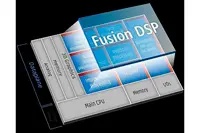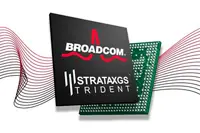Electronics News
Archive : 22 April 2015 год
 Looking to meet the growing need for processing data acquired by sensors, Cadence has launched the Tensilica Fusion digital signal processor (DSP). Based on the Xtensa Customizable Processor, the scalable DSP core is said to be suited to applications requiring DSP computation, ultra low energy consumption and a small footprint.
Looking to meet the growing need for processing data acquired by sensors, Cadence has launched the Tensilica Fusion digital signal processor (DSP). Based on the Xtensa Customizable Processor, the scalable DSP core is said to be suited to applications requiring DSP computation, ultra low energy consumption and a small footprint.
Gerard Andrews, senior product manager with Cadence's audio/voice IP group, said: "Semico has predicted there will be 40billion sensors a year by 2018, which means more data needs to be processed, cleaned, filtered and acted on. In most cases, the devices which will be doing this will be low cost, with low energy requirements."
Cadence sees three factors as being important in IoT devices: sensing; computation; and communications. "The DSP workload associated with these three will increase," Andrews noted, "which is why we are taking a DSP centric focus."
The Tensilica Fusion DSP combines an enhanced 32bit Xtensa control processor with DSP features and flexible algorithm specific acceleration.
Using the Xtensa Processor Generator, IoT device designers can configure the options they need to create an optimised Fusion processor, which can be designed into SoCs for a range of applications.
The configurable elements include floating point support, up to four 16 x 16 MACs and AES-128 encryption.
"In the past," Andrews continued, "vertical DSP products have focused on specific domains. With Fusion, we want to excel in audio, voice and communications, so it's more of a general purpose DSP, with modules running voice and comms stacks." He added that voice control and recognition was featured as Fusion is likely to be used in wearables, where keyword detection is important.
Typical applications for Fusion are likely to be in products with low to medium compute requirements.
Author
Graham Pitcher
Source: www.newelectronics.co.uk
 More than two thirds of those responding to a recent survey said the 'thing' they most wanted to connect to the internet is themselves.
More than two thirds of those responding to a recent survey said the 'thing' they most wanted to connect to the internet is themselves.
The survey, conducted by Premier Farnell's online design engineer community element14, was sent to 3500 adults from Australia, China, France, Germany, India, the UK and the US to find out what emerging technologies are likely to be the most popular for the future.
Of those polled, 69% said they would like to connect themselves to the internet through wearable devices such as smart glasses, watches and fitness devices.
Many of the results show that consumers are looking to improve their communities through emerging technology more than their own standard of living.
When asked what areas product developers should be focusing on, 68% of respondents chose healthcare. "Health is a big issue that arose from the survey," said Dianne Kibbey, global head of community at Premier Farnell. "Being connected to the internet means their wearables can send real time data, not only to their GPs, but also to their families, so their health can be closely monitored."
Other areas that scored highly were renewable energy (66%) and the environment (56%), with clean and affordable energy scoring 86% and 91% respectively.
The study is part of element14's 'Engineering a Connected World' initiative, which includes a series of global design challenges over the next 24 months. The challenges will focus on innovation in energy efficiency, food production and medical technology. In leading them, element14 claims it will oversee the development of more than 100 engineering concepts and prototypes.
Engineers are challenged by element 14 to come up with a good idea. Those selected are provided with what it calls 'design challenge kits' to develop their idea. After a final submission, a panel of judges determines the winners.
Author
Tom Austin-Morgan
Source: www.newelectronics.co.uk
 Broadcom has unveiled the next generation of its StrataXGS Trident Ethernet switch portfolio. Called the Trident-II+ series, the parts are said to be optimised to meet the bandwidth, scalability and efficiency demands of 10GbE virtualised data centres. The company adds the parts can also replace ASICs.
Broadcom has unveiled the next generation of its StrataXGS Trident Ethernet switch portfolio. Called the Trident-II+ series, the parts are said to be optimised to meet the bandwidth, scalability and efficiency demands of 10GbE virtualised data centres. The company adds the parts can also replace ASICs.
Supporting data rates of up to 1.28Tbit/s, the devices consume 30% less power than previous versions whilst offering double the performance. Amongst the part's features are 128 10Gbit/s serial interfaces, along with up to eight 100GbE ports.
Built on Broadcom's StrataXGS architecture, the 28nm Trident-II+ series provides a drop in power and efficiency improvement, as well as feature and performance upgrades.
"Over the past five years, multiple StrataXGS Trident generations have helped drive the adoption of 10GbE in cloud and mega scale data centres with standard, cost efficient, merchant silicon based platforms," said Ram Velaga, general manager of Network Switch for Broadcom. "Our latest Trident-II+ series offers the economics, performance and virtualisation capabilities required to lead a similar transition across enterprise data centres worldwide."
Author
Graham Pitcher
Source: www.newelectronics.co.uk
 Market analyst IHS says worldwide semiconductor revenues grew by 9.2% in 2014, reaching $354.5billion. According to the company, the year ended on a strong note, with fourth quarter revenues showing 9.7% improvement over Q4 2013.
Market analyst IHS says worldwide semiconductor revenues grew by 9.2% in 2014, reaching $354.5billion. According to the company, the year ended on a strong note, with fourth quarter revenues showing 9.7% improvement over Q4 2013.
"While 2014 marked a peak year for semiconductor revenue growth, the health of the semiconductor supply base and end market demand, position the industry for another year of strong growth in 2015," said Dale Ford, IHS' chief analyst. "Overall, semiconductor revenue growth will exceed 5% in 2015 and many component categories and markets will see improved growth over 2014."
Of the top 25 semiconductor suppliers, 21 companies grew in 2014. The four companies suffering declines included three Japanese organisations.
According to IHS, five of the seven major component segments saw improved growth compared to 2013 and all major component markets saw positive growth.
Every application market was found to have delivered strong growth, with the exception of consumer electronics. Industrial electronics led all segments with 17.8% growth, followed by data processing (+13.7%) and automotive electronics (+10%). Demand for wireless communications was not as strong, but the sector still grew by 7.8%.
Intel retained its number one position, growing revenues by 6.3% to $49.96bn; equivalent to a market share of 14.1%. Samsung took the number two slot with sales of $38bn, with Qualcomm at number three ($19.29bn).
Acquisitions still play an important role, says IHS, pointing to MediaTek's purchase of MStar propelling it into the top 10. Similarly, Avago was boosted by its acquisition ofLSI, moving up nine places to number 14.
It believes NXP and Infineon will be competing for positions among the top 10 in 2015 with the boost from their mergers/acquisitions of Freescale Semiconductor and International Rectifier.
Author
Graham Pitcher
Source: www.newelectronics.co.uk
 In a move intended to make cars even safer, STMicroelectronics has expanded its range of multicore microcontrollers and is building them using a proprietary 40nm embedded flash process.
In a move intended to make cars even safer, STMicroelectronics has expanded its range of multicore microcontrollers and is building them using a proprietary 40nm embedded flash process.
In a move intended to make cars safer, STMicroelectronics has expanded its range of multicore microcontrollers and is building them using a proprietary 40nm embedded flash process.
The devices, said to offer a hardware based solution to ISO26262 ASIL-D compliant and high performance real time system requirements for mid and high end powertrain applications, combine compliance with stringent automotive safety standards, encryption for security and increased memory. According to the company, the parts are suited to mission critical applications such as engine management, transmission, anti-lock braking, electric power steering, active suspension and advanced driver assistance systems.
Fabio Marchio, general manager of ST's automotive microcontroller and infotainment division, said: "Offering a simple and compelling upward migration path from existing parts, our new automotive MCUs enable improved vehicle performance and economy with no compromises in security, while delivering savings in development by promoting hardware and software reuse."
The single chip 32bit devices are part of ST's Power Architecture range. Called the SPC58NE product line, the parts feature multiple high performance dual issue cores with up to 6Mbyte of flash and 768kbyte of RAM. The devices feature three e200x4d Power Architecture compliant dual issue cores, with two paired in lockstep. Also included is a lightweight signal processing auxiliary processing unit to handle DSP related tasks.
There are also eight CAN interfaces and a peripheral set that can be optimised for the end application. The multiple cores are said to ensure redundancy to meet safety and security demands.
The SPC58NE product line is currently available in BGA 292 and LQFP176 packages.
Author
Graham Pitcher
Source: www.newelectronics.co.uk
 Cambridge based UltraSoC has added USB based debugging capabilities to UltraDebug. The patented technology is said to allow a single USB 2.0 interface to be used simultaneously for system communication and applications such as debugging.
Cambridge based UltraSoC has added USB based debugging capabilities to UltraDebug. The patented technology is said to allow a single USB 2.0 interface to be used simultaneously for system communication and applications such as debugging.
Cambridge based UltraSoC has added USB based debugging capabilities to UltraDebug. The patented technology is said to allow a single USB 2.0 interface to be used simultaneously for system communication and applications such as debugging.
"We're now able to offer levels of connectivity that befit the advanced features of UltraDebug," said Rupert Baines, pictured, UltraSoC's CEO. "And USB is just the beginning. In a world of 50billion connected devices, being able to optimise an embedded system remotely is a very powerful capability."
The company explains that, traditionally, designers have relied on debug specific interfaces – typically Jtag – to analyse chip behaviour. UltraDebug allows this to be done via the USB interface found in many devices. The approach is said to bring many benefits, including: doing away with the need for dedicated debugging pins; faster data transfer; and an interface that remains accessible.
UltraDebug is delivered as silicon IP for integration into the chip design. It is said to be compatible with IP and processor blocks from any vendor and to be 'particularly powerful' when used in systems that include IP from multiple sources. Advanced security features are also integrated.
Future developments will support other standard interfaces, such as Ethernet or PCIe.
Author
Graham Pitcher
Source: www.newelectronics.co.uk
 Have you developed breakthrough technology, grown an innovative business or excelled in a specialist field? If so, why not enter your company into the 2015 British Engineering Excellence Awards – or BEEAs.
Have you developed breakthrough technology, grown an innovative business or excelled in a specialist field? If so, why not enter your company into the 2015 British Engineering Excellence Awards – or BEEAs.
The BEEAs reward companies who have shown innovation in design within the last year, as well as the design engineers who made the innovations possible.
The 2015 categories are:
- Consultancy of the Year
- Design Engineer of the Year
- Design Team of the Year
- Green Product of the Year
- Materials Application of the Year
- New Product of the Year (Electronic)
- New Product of the Year (Mechanical)
- Small Company of the Year
- Start-up of the Year
- Young Design Engineer of the Year
The online entry process is very easy to complete and is totally free. The deadline for submissions is Friday 24 July 2015.
Author
Graham Pitcher
Source: www.newelectronics.co.uk
 A technique developed by a research team from the University of Delft is said to be capable of producing fast, low power and flexible polycrystalline silicon transistors at low cost. Tests showed the thin film transistors created using the process exhibited mobilities as high as those of conventional polysilicon conductors.
A technique developed by a research team from the University of Delft is said to be capable of producing fast, low power and flexible polycrystalline silicon transistors at low cost. Tests showed the thin film transistors created using the process exhibited mobilities as high as those of conventional polysilicon conductors.
The team says the ability to print silicon ink onto substrates has existed for some time, but the process has required a 350°C thermal annealing step – too hot for many of the flexible surfaces that developers might want to use. The method is said to bypass this step by treating liquid silicon ink with a single laser pulse.
"It was very simple," said Professor Ryoichi Ishihara, who led the Delft research team, with collaborators at the Japan Advanced Institute of Science and Technology. "We coated liquid polysilane directly on paper by doctor blading in an oxygen free environment. Then we annealed the layer with an excimer laser. And it worked," he said.
The most immediate application of the method is said to be in wearable electronics. However, Prof Ishihara believes the team's work, which involves improving the production process to include additional non silicon layers, will enable further applications.
"The process can be expanded to biomedical sensor and solar cells," Prof Ishihara added, "and will also realise stretchable – even edible – electronics!"
pic: R Ishihara, M Trifunovic, TUDelft. A high-mobility polysilicon layer was directly formed on paper by coating liquid silicon, which was annealed by pulsed laser-light.
Author
Graham Pitcher
Source: www.newelectronics.co.uk
 ARM says its Q1 revenues grew by 22% over the same quarter of 2014, a position it ascribes to continuing momentum in licensing of advanced technology, as well as a growth in the shipments of devices featuring ARM processors.
ARM says its Q1 revenues grew by 22% over the same quarter of 2014, a position it ascribes to continuing momentum in licensing of advanced technology, as well as a growth in the shipments of devices featuring ARM processors.
ARM says its Q1 revenues grew by 22% over the same quarter of 2014, a position it ascribes to continuing momentum in licensing of advanced technology, as well as a growth in the shipments of devices featuring ARM processors.
ARM's Q1 revenue was £227.5million, 22% higher than the £186.7m recorded in 2014. However, when stated in dollars, revenues only showed a 14% increase to $348.2m.
Amongst the Q1 highlights were licenses signed for four ARMv8-A processors and two POP licenses, including one which will see a Cortex A-53 processor implemented on a 28nm process. Meanwhile, 3.8billion ARM based chips were shipped in Q1, 31% more than in the same period in 2014.
Pete Hutton, executive vp and president of ARM's product groups, noted than 1bn more ARM based chips had shipped in Q1 2015 than in the same period last year. "And five of the top 10 chip makers took licenses," he added.
The company signed 30 processor licences in Q1 2015, eight of which were for Cortex-A series processors. It says it has now signed 68 processor and architecture licences for the ARMv8-A. Meanwhile, 16 further licences were signed for Cortex-M class devices, taking the total number for this class to 300.
"There has also been a big investment in Cortex-M class devices," Hutton noted, "and we have built a design centre in Taiwan to focus on this area."
Hutton also pointed to growing interest in ARM's 64bit v8 architecture, claiming 20% of Cortex-A class shipments are now v8 based. "And that's likely to grow to about 50% by the end of the year."
Author
Graham Pitcher
Source: www.newelectronics.co.uk

